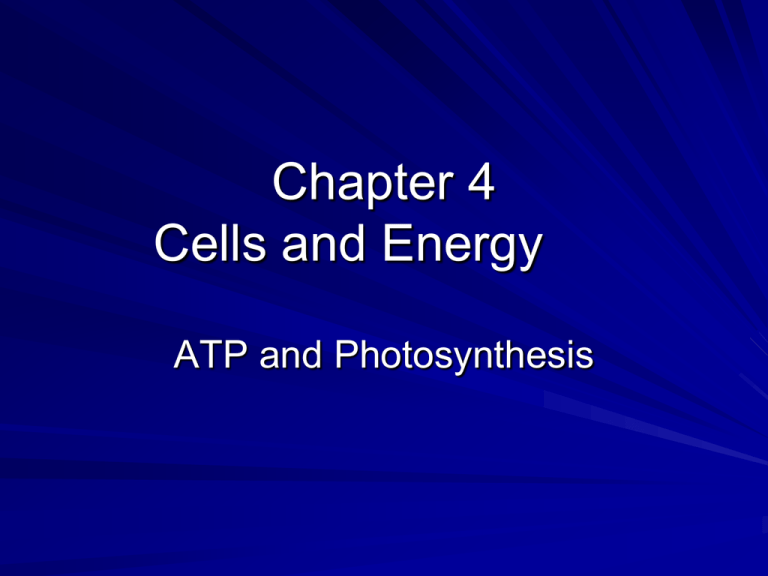Chapter 10 - Cloudfront.net
advertisement

Chapter 4 Cells and Energy ATP and Photosynthesis Work Is done when anything is moved Life processes rearrange molecules, ions, and atoms Requires energy Energy Is the ability to do work Comes from food Food is broken down into small molecules that can enter cells Cells break down molecules to release the energy Energy from molecules Is not all used at one time Used to balance supply and demand Energy not used right away is stored in a molecule called ATP ATP releases the energy when the cell needs it Cells die without ATP ATP Adenosine triphosphate – Sugar (ribose) – Adenine – 3 phosphate groups – Energy is stored in the phosphate-phosphate bonds – When a phosphate is removed, energy is released to the cell – ADP is left ADP Adenosine diphosphate – Sugar (ribose) – Adenine – 2 phosphate groups – Is recycled by adding another phosphate to store energy – Putting another phosphate on ADP converts it back to ATP ATP / ADP Cycle Energy cycle ADP + P + energy = ATP ATP – Energy available for work is free energy – Energy stored in molecules is potential energy – ATP is the energy link between energy-using and energy-releasing reactions Autotrophs Trap energy from sunlight for photosynthesis Most plants are green because of chlorophyll (green pigment) Chlorophyll reflects green light Energy from sun is trapped inside thylakoid membrane of chloroplast To return to the chapter summary click escape or close this document. Photosynthesis 2 groups of reactions: light reactions and Calvin cycle (dark reactions) Light reactions – Light converted to chemical energy – Photo part – Split water and give hydrogen to Calvin cycle Calvin cycle – Forms sugar from CO2 and H (from water) – Synthesis part Light reactions Electrons in chlorophyll absorb light energy Electrons leave chlorophyll and are passed through electron transport chain Extra energy is stored as ATP Water is split into O2 and H+ (photolysis) H + electron picked up by NADP+ (electron carrier) O2 given off as waste Photolysis To return to the chapter summary click escape or close this document. Calvin Cycle Enzyme adds C from CO2 to a 5-carbon molecule C is not fixed to an organic molecule (carbon fixation-coverts gaseous CO2 to a useable form for living things: sugars, starch, cellulose) Called dark reactions because light does not have to be available for fixation (CO2) The Calvin Cycle (Unstable intermediate) (RuPB) ADP + ATP ATP ADP + NADPH NADP+ (PGAL) (PGAL) (Sugars and other carbohydrates) (PGAL) Life without light Some organisms are chemosynthetic (bacteria) Obtain energy by converting inorganic compounds into useable forms Usually final participants in decomposition processes

